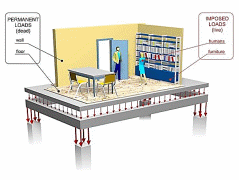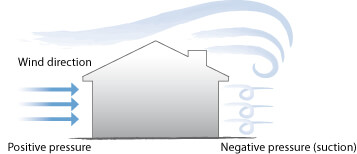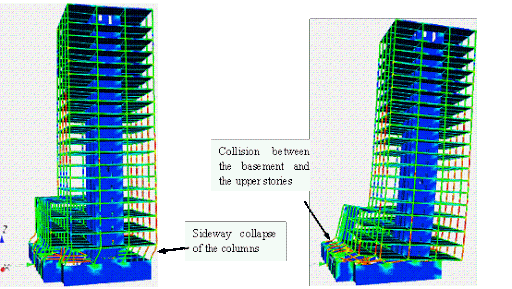Introduction
Analysis of structures is important for safe design and serviceability to resist loads coming from various sources. These loads re taken into account while designing so that the building does not fail under the application of these loads. These loads may be in the form of uniformly distributed load, concentrated load, triangular load and so on. All these have various points of application and so the center of mass is to be detected for making the calculations easy in every aspect. For example, in seismic zones, the earthquake load plays an important role which is to be considered in seismic analysis. Similarly, in some areas wind is the predominant force and it imposes load on the building which needs to be analysed before any disaster strikes. All these loads create a significant impact in performing structural analysis and any slight calculation mistakes can create life threatening situations.
Types of loads
There are various types of loads that are studied in the structural analysis which are –
-
- Dead Load – As the name suggests, it is the load that constantly acts on the building despite of any circumstances, hence the name. It comprises the self weight of beams, columns, slabs, staircases, chajja and many other building elements. These loads are permanently adhered to the structure and are generally referred to as stationary loads. Shuttering is one such case which is not considered dead load since it is removed from the structure as soon as the concrete takes its shape. This dead load is often used in the calculation of volume of members of structures. Some of the standard dead load values are –
- Plain Cement Concrete or PCC = 24 kN/m3
- Reinforced Cement Concrete or RCC = 25 kN/m3
- Steel = 78.5 kN/m3
- Wood = 8 kN/m3
- Brick masonry, cement plaster = 20 kN/m3
- Stone masonry = 24 kN/m3
- Floor finish = 0.6 to 1.2 kN/m3
- Live load – It is also known as the Imposed Load. These loads keep changing from time to time as they are not permanently adhered to the structure. Examples of live load are human walking inside a building, furniture kept on floor, equipment, etc. All these loads are dynamic in nature and can be transferred from one position to another. For reference it is recommended to look in IS 875 (Part 2)- 1987 for minimum values of live load in residential buildings, educational buildings, institutional buildings, storage rooms, business and office buildings, mercantile buildings, and assembly buildings. For seismic calculations generally the live load on roof is taken as 2 kN/m3.
- Dead Load – As the name suggests, it is the load that constantly acts on the building despite of any circumstances, hence the name. It comprises the self weight of beams, columns, slabs, staircases, chajja and many other building elements. These loads are permanently adhered to the structure and are generally referred to as stationary loads. Shuttering is one such case which is not considered dead load since it is removed from the structure as soon as the concrete takes its shape. This dead load is often used in the calculation of volume of members of structures. Some of the standard dead load values are –

Fig 1: Depiction of live and dead load in a room
Courtesy: BuildingHow
- Wind Load – It is the load due to horizontal component of wind that depends upon the velocity of the wind and shape as well as size of the building. IS 875 (Part 3) -1987 deals in wind load on buildings. Basic wind pressure Vb is show on a map of India using colour codes. The value of Vb is selected depending upon the locality of the building. To obtain the design wind velocity Vz, the following expression is to be used
Vz = k1 k2 k3 Vb
Where, k1= Risk coefficient, k2 = Coefficient based on terrain, height, and structure size and k3 = Topography factor. The Design wind pressure is given by
pz = 0.6 Vz2
where, pz is in N/m2 at height z and Vz is in m/sec. Till a height of 30 m, the wind pressure is considered to act uniformly on the building. When the height is above 30 m, the wind pressure increases.

Fig 2: Wind load acting on a building
Courtesy: Dlsweb..rmit.edu.au
- Snow Load – This is the load caused by the accumulation of snow in cold climatic areas. These loads are calculated on the basis of snow projections at different parts of the structure. It depends upon the height, shape and size of the building. IS 875 (Part 4)-1987 deals in snow loads for the design of buildings. The minimum snow load is given by the expression
S = µS0
where, S = Design snow load, µ = Shape coefficient and S0 = Ground snow load. This load is not the outcome of single impact but the result of multiple impact of snow. Such loads cause imbalance on the roof of the structure and hence needs to be treated for the safe design of structures.

Fig 3: Snow load acting on a building
Courtesy: Band Premier Real Estate
- Earthquake Load – Dynamic horizontal loads act on the structure in cases of earthquake. Hence seismic design is necessary for earthquake prone areas to reduce hazard. IS 1893- 2016 deals with such seismic loads and IS 13920-2016 deals in details of structural members that are to be designed in accordance with earthquake load. The response of the structure to the ground vibration is a result of the soil condition of foundation as well as size, duration and intensity of ground motion. According to Bureau of Indian Standards (BIS), the seismic location of India is divided in zones which are – Zone II, Zone III, Zone IV, Zone V.

Fig 4: Collapse simulation of an RCC Building
Courtesy: Xinzheng Lu
Conclusion
All these loads have different impact on buildings. Different areas have different weather conditions which in turn have impact on variety of loadings. Some areas may experience combinations of loading too like DL+LL+EL or DL+LL+WL and so on. Several load combinations are needed to evaluate while designing of buildings and the maximum load is to be taken into consideration for the safe design of structure. Moreover, the building codes are different in different countries and so the loading calculations may slightly vary. It is to be remembered the standard values so that calculations become easy in every aspect of building design. Apart from these loads there are other loads that are considered in building design and are evaluated based on different building codes. Such loads are not vital compared to the loads explained above but are important to be considered for better design.
If you have a query, you can ask a question here.


